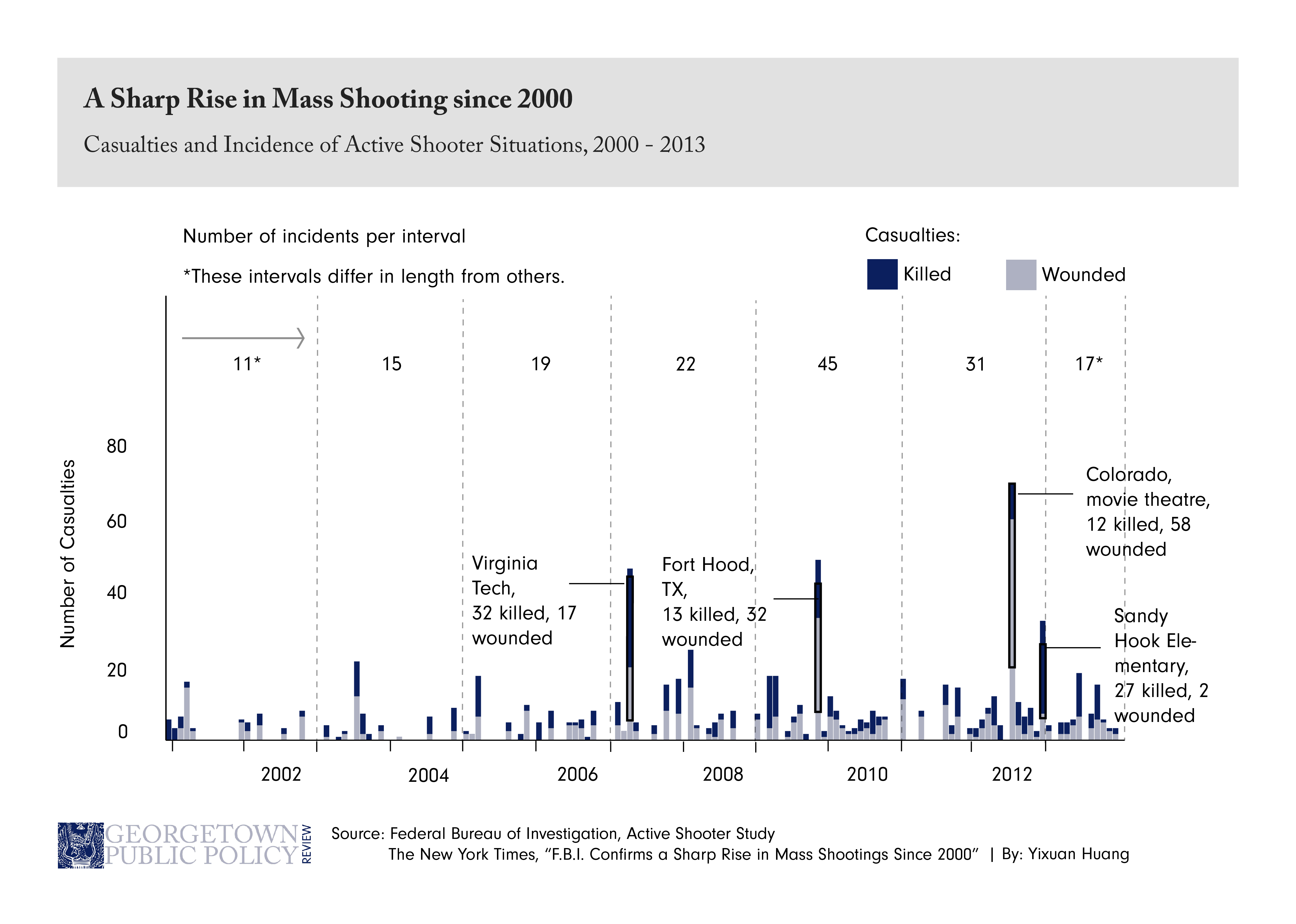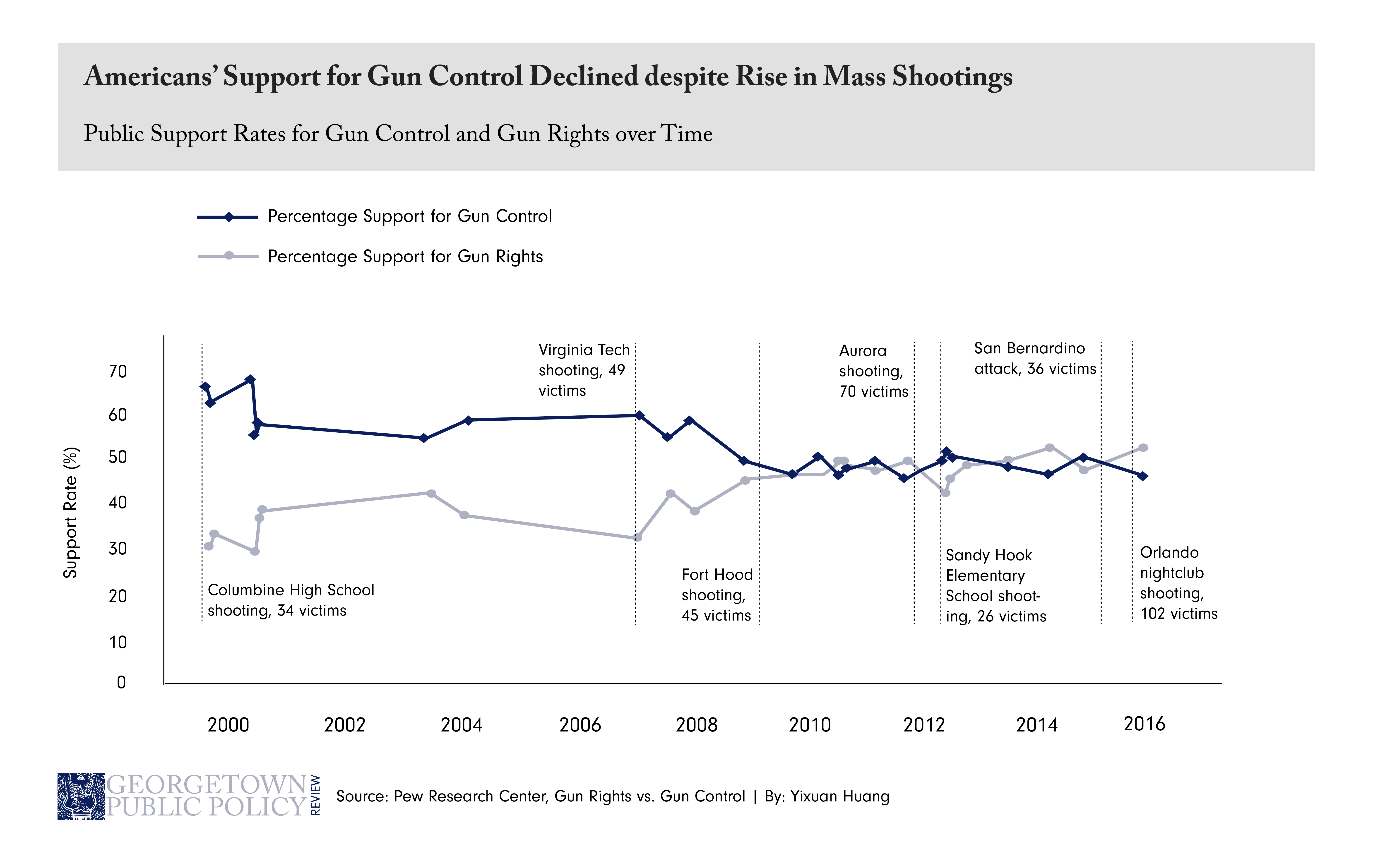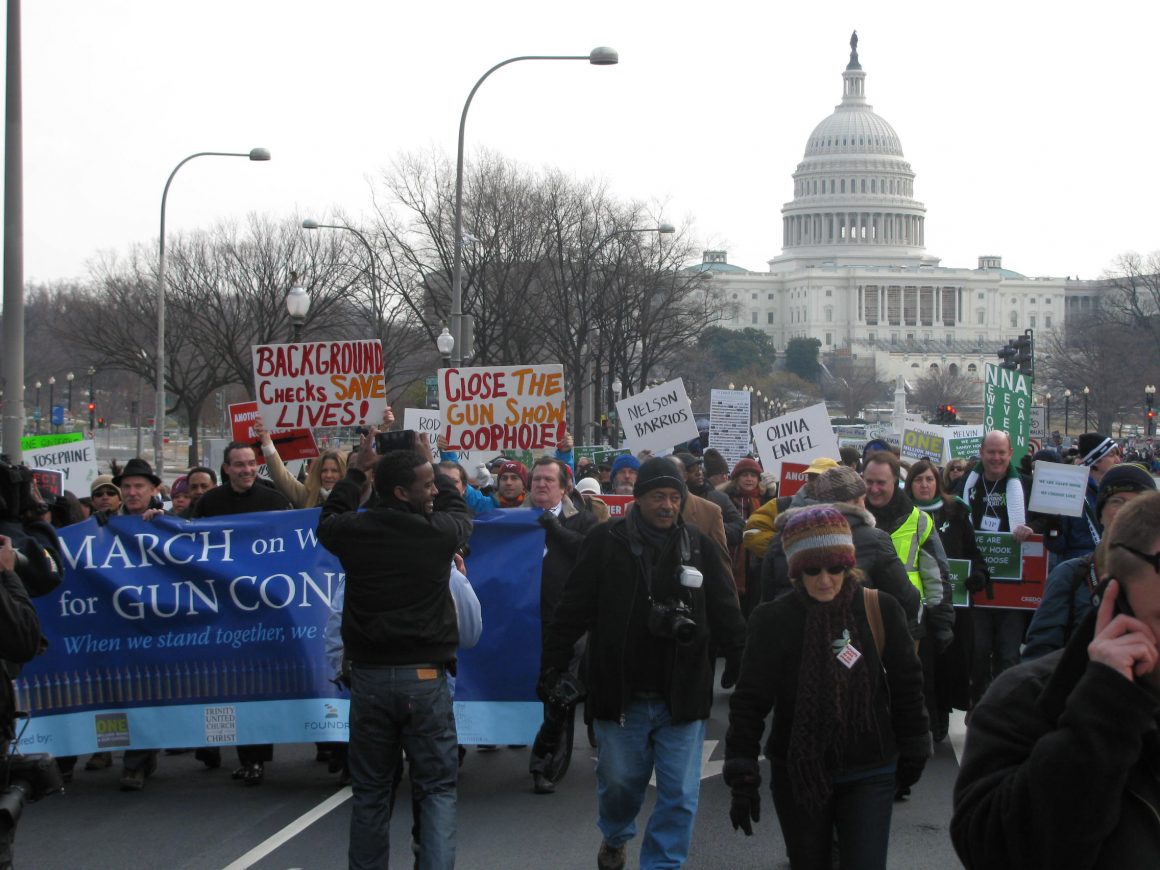Legislative History
America has a long and dialectical history when it comes to gun rights. The Second Amendment to the Constitution pronounces, “A well regulated Militia, being necessary to the security of a free State, the right of the people to keep and bear Arms, shall not be infringed.” Held as a protective measure against tyranny, the right to own guns was enshrined in the Constitution after the American Revolution. As guns and society have evolved over the last two hundred years, however, the United States has had to adapt its treatment of firearms. The early 20th century saw a rise in gun crime, with mob violence and tommy guns bringing firearms to national attention. To combat this rising crime wave, Franklin Delano Roosevelt enacted the first restrictive federal gun legislation in 1934, establishing machine gun taxes and beginning the first registry of sales. After a slew of high-profile assassinations in the 1960s, such as the Kennedy brothers’ deaths and the murder of Martin Luther King Jr., Lyndon B. Johnson pursued enhanced gun control legislation. His Gun Control Act of 1968 was the foremost federal firearm regulation of its time, placing ownership restrictions on convicted criminals, mentally ill individuals, and more.
Each step forward in gun control legislation tends to produce retaliatory pushback. Congress reacted to Johnson’s restraints in the 1980s, enacting legislation to limit the Bureau of Alcohol, Tobacco, and Firearms’ powers. However, tighter restrictions on machine guns were also passed at that time, which remain in effect to this day. The 1990s brought renewed action on restricting access. Although barred from creating a federal registry of ownership, The Brady Act of 1993 established the National Instant Criminal Background Check System (NCIS) to help prevent unlawful sales. Shortly thereafter, Congress passed a 10-year federal ban on semi-automatic weapons. Yet, by the early 2000s, restrictions on federal gun sale data were passed and efforts to reauthorize the semi-automatic ban failed. Gun manufacturers were also granted immunity from civil lawsuits on gun crime, and in 2008 District of Columbia vs. Heller ruled that individuals can own guns for personal use. The Supreme Court upheld this ruling for state and local jurisdictions as well, overturning several city-wide handgun bans. Today, gun laws range from state to state, while meaningful federal action has failed to respond to a growing number of mass shootings.
Gun Violence in the United States
On average, the United States experiences about 33,000 gun deaths per year, approximately 12,000 of which are homicides. Over 50% of these homicides are young men, two thirds of whom are black. Of particular interest when it comes to media coverage, however, are mass shootings. In 2016 alone, there were 385[1] total mass shootings, defined here as four or more people shot in a single event. Furthermore, the number of mass shootings in America has risen significantly in recent years; between 1982 and 2012, the country experienced fewer than 200 reported mass shootings. To put this in context, the United States has about 5% of the world’s population, but represents 31% of all mass shootings between 2000 and 2012. The United States also has the highest rate of gun ownership per capita, with about 89 firearms per 100 people. Clearly, the United States has a problem, a problem that is linked to its widespread availability of guns, as well as a myriad of cultural and political factors.

High profile mass shootings have dominated news coverage in recent years. The Sandy Hook massacre is particularly important to more recent debates on gun control, when outrage sparked after twenty children and six adults were murdered in 2012. The San Bernardino shooting, during which two shooters killed fourteen people in 2015, recently brought gun control back into the national eye after the Sandy Hook killings. The 2016 Orlando shooting, when a gunman murdered forty-nine people at Pulse nightclub, remains the deadliest shooting to date. These murders, along with hundreds of other mass shootings, necessitate a national debate on rights and safety.
The Gun Control Debate
Currently, the American gun control dispute is polarized, and tends to separate along party lines. Gun control advocates point to the statistics, arguing that too many Americans are killed each year in gun-related incidents, and restricting access to firearms could reduce these numbers. The central argument states that the average person should not be able to use semi-automatic or assault weapons, and sensible restrictions can save lives. Most gun control advocates are not aiming to take away everyone’s guns, especially not from law abiding citizens, but aspire to create a more efficient system to keep guns out of dangerous hands. The data to support the efficacy of these policies is inconclusive, however.
On the other hand, opponents of gun control argue that firearm ownership is a matter of individual freedom. Pointing to the Second Amendment, they assert that individual rights to bear arms are protected by the Constitution, and more recently by Supreme Court legislation. An armed population is safer from crime and victimization, and armed citizens can even stop a mass shooter, they argue. Similarly, data on whether or not guns make the population safer from attack, or help prevent mass shootings, is incomplete. One reason there is so much uncertainty around the efficacy of gun control legislation is that Congress has essentially banned gun research by the Center for Disease Control and Prevention by prohibiting studies that could promote gun control, and refusing to appropriate funds even after President Obama’s executive order for gun research.

Public opinion is generally split between the two camps. Pew Research Center finds that the gap between supporting gun control versus gun ownership, historically favoring control by wider margins, has converged. As of August 2016, 52% of the American public now supports gun rights over control, versus 46% supporting control. However, measures like background checks and expanded restrictions for people already on federal watch lists enjoy broader public support, while the American people remain divided when it comes to banning specific weapons and munitions.
Overall, America’s relationship with firearms is complicated, with a long history of changing public opinion and dialectic legislative controls. However, high numbers of gun deaths and rising incidents of mass shootings necessitate a more immediate conversation and a closer look at how we treat firearm.
[1] This number is debated according to different definitions of “mass shooting”. Mass Shooting Tracker puts this number at 476 mass shootings and 604 dead in 2016, using a slightly more inclusive definition of “a single outburst of violence in which four or more people are shot”.
Delaney Luna is a second year MPP candidate at Georgetown University’s McCourt School of Public Policy. Earning her B.A. at the University of California, Berkeley, she studied political economy and public policy while working in a variety of local government, political, and academic settings. Her policy interests include financial security and economic inclusion, and her most recent work experience includes nonprofit asset-building. Delaney is originally from Coronado, CA.

I find it disappointing that Georgetown’s public policy journal would cite a brief and sloppy Washington Post article as a source for these 2 key and sweeping statements:
1) The data to support the efficacy of these policies [to keep guns out of dangerous hands] is inconclusive….
2) data on whether or not guns make the population safer from attack, or help prevent mass shootings, is incomplete.
Instead, I would suggest using recent scholarly work done by the Center for Gun Policy and Research at Johns Hopkins, for instance, showing the uptick in homicides in Missouri after repeal of its permit to purchase law or Stanford’s School of Law report showing that right to carry laws increase aggravated assaults. Most disturbingly, one of the research sources cited in the Post article that this article echoes is the thoroughly discredited pro-gun proponent John Lott who among other things has done “scholarly research” that blamed women getting the vote as the cause of government expansion and more liberal policies and blamed liberalizing abortion laws for increasing murder rates. Really, I would expect Georgetown Public Policy Review to do better.
Oddly, there was no mention of the FBI Uniform Crime Report or the Department of Justice’s National Institute of Justice/Bureau of Justice Statistics over the last quarter century that report a sharp plunge in gun deaths and violent crime in general. That same quarter century period of plunging violent crime in America coincided with triple the number of semiautomatic high capacity tactical rifles, quadruple the number of semiautomatic high capacity pistols, over 20 million concealed weapons licensees in all 50 states, relaxed laws on the non-licensed transport of firearms in vehicles, and possession of weapons in travel lodging. When suicides, accidents and justifiable deaths from firearms are subtracted from the total “gun deaths” figure, the actual number of criminal homicides is closer to 6,000±, still high in the cost of human lives, but only a fraction of the 33,000 ± claimed by a long discredited gun control effort in this country.